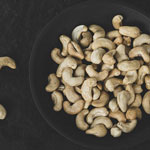National Cashew Day Date in the current year: November 23, 2026
 National Cashew Day is observed annually on November 23. It was created to celebrate a popular snack nut, which is, technically, not a nut from a botanical point of view but is considered a nut in a culinary sense.
National Cashew Day is observed annually on November 23. It was created to celebrate a popular snack nut, which is, technically, not a nut from a botanical point of view but is considered a nut in a culinary sense.The cashew tree is a large evergreen tree native to South America. Portuguese explorers discovered it in the 16th century and helped distribute it to tropical regions around the world. They took cashew from Brazil to Goa, which was a Portuguese colony back then, in the 1560s; from there, it spread throughout Southeast Asia and eventually Africa.
The fruit of the cashew tree consists of a pear-shaped accessory fruit called the cashew apple and a kidney-shaped drupe (seed) growing at its end. The seed is commonly referred to as the cashew nut or simply cashew. Even though it is not a nut in a botanical sense, cashew is grouped with nuts in a culinary context due to its high protein and fat content.
The cashew tree is cultivated in tropical regions around the globe. According to FAO, the world’s top five cashew-producing countries as of 2020 were Côte d’Ivoire (Ivory Coast), India, Vietnam, Burundi, and the Philippines. However, the top five exporters of cashew nuts in value as of 2021 were Ghana, Tanzania, Guinea-Bissau, Nigeria, and Côte d’Ivoire.
Like all culinary nuts, cashews are rich in fat, protein, vitamins, and dietary minerals. They are an excellent source of B vitamins, vitamin K, copper, phosphorus, magnesium, manganese, zinc, iron, selenium, and potassium. Cashews are a common ingredient in South Asian cuisine. They can be used to garnish curries or sweets, or ground into a paste used to make sauces or desserts.
Cashew nuts also are a popular snack, as well as a source of plant milk and vegetable oil. Cashew oil is commonly pressed from broken chunks left over from processing cashew nuts; it can be used as a cooking oil or as a salad dressing. Cashew milk is a plant alternative to dairy milk; it is sometimes used in plant milk blends such as almond-cashew milk.
The shell of the cashew nut contains toxins that can cause contact dermatitis, so cashews are usually sold without the shell. Waste cashew shells are a source of substances that can be used in the production of coatings, lubricants, paints, resins, etc.
Cashew apples are mainly consumed in cashew-producing countries because they are hard to transport and have a short shelf life. They can be eaten fresh, used to make curries, chutneys, jams, preserves and non-alcoholic beverages, and fermented into an alcoholic drink or vinegar.
Cashews are one of the most popular snack nuts, so it is not surprising that there is an unofficial holiday dedicated to them. The origins of National Cashew Day are murky, but it has been celebrated since at least 2015. You can observe it by snacking on cashews, enjoying a toast with cashew butter, using cashews in a recipe (these nuts can be used in a variety of dishes, ranging from baked goods and desserts to stews and salads), and spreading the word about the holiday on social media using the hashtags #CashewDay and #NationalCashewDay.
- Category
- Unofficial Holidays
- Country
- USA
- Tags
- National Cashew Day, unofficial holidays, observances in the US, food days, food holidays, cashew nuts